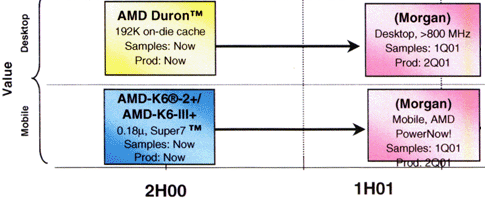AMD CPU & Chipset Roadmap - November 2000
by Anand Lal Shimpi on November 21, 2000 6:13 PM EST- Posted in
- CPUs
Super7’s Replacement
It was only a matter of time before AMD’s Duron began to threaten the domain once held by the K6-X processors. The value market was AMD’s where AMD was gaining ground last year, but as we announced at the start of this article their focus has changed as the Athlon is definitely not a value desktop part.
AMD’s goal for 2001 is also to regain some of that value market share that was lost to Intel’s Celeron. We have seen time and time again that the Duron is clearly a better processor when compared to the Celeron, and is much faster on a clock for clock basis, however, at least in North America, the Duron hasn’t seen the kind of retail support that Intel’s Celeron continues to enjoy.
Without any major system design wins for the Duron, the Celeron is allowed to dominate in the retail market. A big factor that has kept the Duron out of many systems is that it is lacking any low cost platform with integrated video to run on. To most hardware enthusiasts this is actually a positive point about the Duron, since we all know how slowly Quake III will play on the “fastest” integrated video chipsets. But in the retail market, when a manufacturer is trying to sell a system at the lowest possible price to a user that’s only going to be really surfing the net and typing up documents in Word, video performance isn’t the top priority.
We’ll address AMD’s chipset roadmap later on to see if the Duron will be paired with a low cost platform, but before we do that let’s have a look at the future of the processor itself.
By the end of this year the K6-X line of Super7 processors will be phased out, and the Duron will be allowed to grow into the value mobile market as well as the value desktop market that it has been developing in as well.
If you recall back to our initial review of the Duron back in June you’ll remember that the Duron is a direct derivative of the Athlon’s Thunderbird core. With the Thunderbird due to be replaced by the Palomino core it would make a lot of sense for the Duron to get a new, cooler running core that is based on the Palomino core as well.
So in the second quarter of 2001 AMD will release the Morgan core, it will feature the same 192KB total on-die cache as the current Duron (128KB L1 + 64KB L2) and will run approximately 20% cooler than the current Durons that are using the Spitfire core.

The Morgan will also be going mobile around the same time and it will replace the mobile K6-2+ and K6-III+ CPUs in the value mobile market segment. Just as with the mobile Palomino, the mobile Morgan will be identical to its desktop counterpart while adding PowerNow! support and will ship at lower clock speeds.
The final step for the Duron on AMD’s current roadmap is the transition to the Appaloosa core, which is the Duron derivative of the Athlon’s Thoroughbred core. This core will be due out in the second quarter of 2002 and will be using AMD’s 0.13-micron fabrication process just like the Thoroughbred.










0 Comments
View All Comments